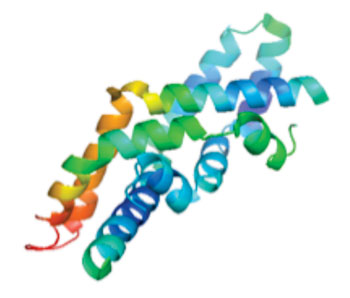Nanovesicles Kill Human Lung Cancer Cells in Culture and in a Mouse Xenograft Model
By LabMedica International staff writers
Posted on 25 Feb 2015
Nanovesicles assembled from the protein Saposin C (SapC) and the phospholipid dioleoylphosphatidylserine (DOPS) were shown to be potent inhibitors of lung cancer cells in culture and in a mouse xenograft model.Posted on 25 Feb 2015
Saposin C is a multifunctional protein known to activate lysosomal enzymes and induce membrane fusion in an acidic environment. Excessive accumulation of lipid-coupled saposin C in lysosomes is cytotoxic. Because tumors generate an acidic microenvironment, caused by leakage of lysosomal enzymes and hypoxia, it was hypothesized that saposin C may be an effective anticancer agent.

Image: Molecular model of the protein Saposin C (Photo courtesy of Wikimedia Commons).
SapC–DOPS nanovesicles had been shown previously to target phosphatidylserine, an anionic phospholipid preferentially exposed in the surface of cancer cells and tumor-associated vasculature. Since binding of SapC to phosphatidylserine is favored at acidic pHs, and the latter characterizes the milieu of many solid tumors, investigators at the University of Cincinnati (OH, USA) and their colleagues at Nanjing Medical University (China) tested the effect of pH on the binding capacity of SapC–DOPS to lung tumor cells and the influence of the nanovesicles on the viability of the cells.
Results published in the February 2015 online edition of the journal Molecular Cancer Therapeutics revealed that, as expected, SapC–DOPS binding to cancer cells was more pronounced under acidic conditions. Viability assays on a panel of human lung tumor cell cultures showed that SapC–DOPS cytotoxicity was positively correlated with cell surface phosphatidylserine levels, whereas mitochondrial membrane potential measurements were consistent with apoptosis-related cell death.
Using a fluorescence tracking method in live mice, the investigators showed that SapC–DOPS specifically targeted human lung cancer xenografts, and that systemic therapy with SapC–DOPS induced tumor apoptosis and significantly inhibited tumor growth without negatively affecting normal tissues.
Senior author Dr. Xiaoyang Qi, professor of hematology-oncology at the University of Cincinnati, said, "Using a double-tracking method in live models, we showed that the nanovesicles were specifically targeted to the tumors. These data suggest that the acidic phospholipid phosphatidylserine is a biomarker for lung cancer, as it has been found to be for pancreatic and brain tumors in previous studies, and can be effectively targeted for therapy using cancer-selective SapC-DOPS nanovesicles. We observed that the nanovesicles selectively killed human lung cancer cells, and the noncancerous, or untransformed cells, remained unaffected. This toxic effect correlated to the surface exposure level of phosphatidylserine on the tumor cells. Our results show that SapC-DOPS could be a promising treatment option for lung cancer worthy of further clinical study."
Related Links:
University of Cincinnati
Nanjing Medical University














